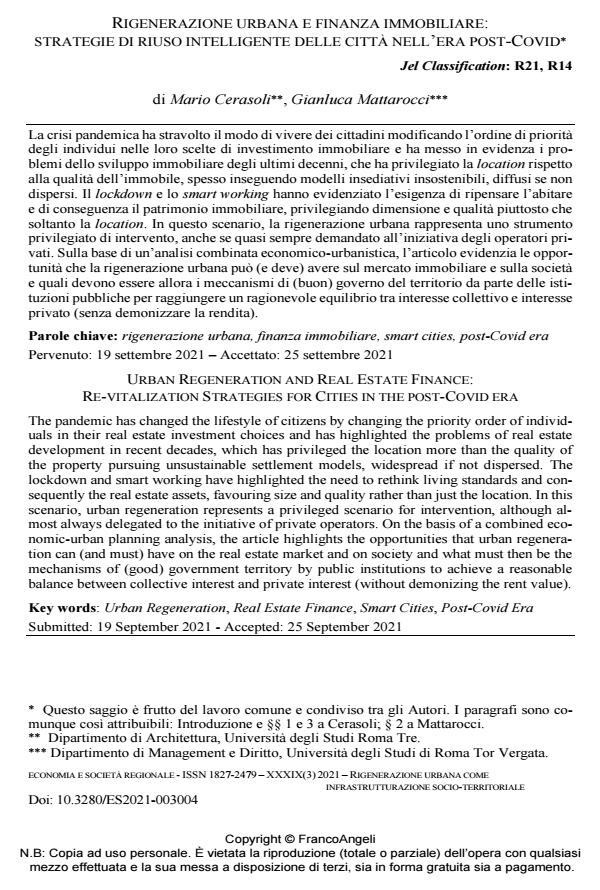Urban regeneration and real estate finance: re-vitalization strategies for cities in the post-covid era
Journal title ECONOMIA E SOCIETÀ REGIONALE
Author/s Mario Cerasoli, Gianluca Mattarocci
Publishing Year 2022 Issue 2021/3 Language Italian
Pages 16 P. 45-60 File size 497 KB
DOI 10.3280/ES2021-003004
DOI is like a bar code for intellectual property: to have more infomation
click here
Below, you can see the article first page
If you want to buy this article in PDF format, you can do it, following the instructions to buy download credits

FrancoAngeli is member of Publishers International Linking Association, Inc (PILA), a not-for-profit association which run the CrossRef service enabling links to and from online scholarly content.
The pandemic has changed the lifestyle of citizens by changing the priority order of individu-als in their real estate investment choices and has highlighted the problems of real estate de-velopment in recent decades, which has privileged the location more than the quality of the property pursuing unsustainable settlement models, widespread if not dispersed. The lock-down and smart working have highlighted the need to rethink living standards and conse-quently the real estate assets, favouring size and quality rather than just the location. In this scenario, urban regeneration represents a privileged scenario for intervention, although almost always delegated to the initiative of private operators. On the basis of a combined economic-urban planning analysis, the article highlights the opportunities that urban regeneration can (and must) have on the real estate market and on society and what must then be the mecha-nisms of (good) government territory by public institutions to achieve a reasonable balance between collective interest and private interest (without demonizing the rent value).
Keywords: Urban Regeneration, Real Estate Finance, Smart Cities, Post-Covid Era
Jel codes: R21, R14
- Agenzia delle Entrate e Mef (2019). Gli immobili in Italia - 2019 -- <https:// www.agenziaentrate.gov.it/>.
- Agenzia delle Entrate (2021) Rapporto immobiliare - 2021 -- <https:// www.agenziaentrate.gov.it/>.
- Amato C. (2021). Il Diritto alla mobilità. Riequilibrio territoriale, mobilità sostenibile e inclusione sociale nelle strategie di rigenerazione urbana. Roma: Aracne Editrice.
- Banca d’Italia (anni vari). Sondaggio congiunturale sul mercato delle abitazioni in Italia -- <https://www.bancaditalia.it/pubblicazioni/sondaggio-abitazioni/index.html>.
- Barca F., Casavola P., Lucatelli S. (2014). Strategia Nazionale per le Aree Interne: definizioni, obiettivi, strumenti e governance. Materiali Uval, 31.
- Campagnoli A. (2021), Social Equity e Debt Crowdfunding: recupero immobiliare tramite lo sviluppo delle imprese sociali e, in generale, del terzo settore. In: Cerasoli M., Mattarocci G., a cura di. Un futuro per i Centri storici. Scenari possibili nell’era post Covid. Roma: Aracne.
- Cerasoli M. (2008). Periferie urbane degradate. Regole insediative e forme dell’abitare. Come intervenire? Roma: Cittalia - Anci Ricerche
- Cerasoli M. (2021). Small Historical Centres: an opportunity for the “smart” revitalization of Inner Areas in the Post (post) Covid Era. Technical Transactions, 5.
- Cerasoli M., Amato C. (2020). Il diritto alla mobilità. Ipotesi per una pianificazione anti-fragile. Le nuove comunità urbane e il valore strategico della conoscenza. Atti della Conferenza internazionale Urbanpromo XVII Edizione. Progetti per il Paese:9-18. Roma-Milano: Planum Publisher.
- Cerasoli M., Amato C., Ravagnan C. (2021). An antifragile strategy for Rome post-Covid mobility. XXV International Conference Living and Walking in Cities LWC - New scenarios for safe mobility in urban areas. ScienceDirect - Transportation Research Procedia.
- Cerasoli M., Mattarocci G. (2020). La rendita come strumento di rilancio del riuso intelligente (e contro l’insostenibile cultura del nuovo) | The land rent as a tool for reuse of existing real estate (against the policy of unsustainable growth of “new” real estate development). valori e valutazioni, 27: 101-110.
- Dall’O G. (2014). Smart City. La rivoluzione intelligente delle città. Bologna: il Mulino
- Governo italiano (2021). Pnrr - Piano Nazionale di Ripresa e Resilienza -- <https://www.governo.it/sites/governo.it/files/PNRR_0.pdf>.
- Imm - Intendencia Municipal de Montevideo (2019). Proyecto Fincas Abandonadas. Hacia una política departamental de recuperación de inmuebles abandonados. Montevideo.
- Istat (2011). Censimento della popolazione -- <http://dati-censimentopopolazione.istat.it/Index.aspx>.
- Mattarocci G. (2021). Centri storici minori e mercato immobiliare post Covid-19. In: Cerasoli M., Mattarocci G., a cura di. Un futuro per i Centri storici. Scenari possibili nell’era post Covid. Roma: Aracne.
- Moreno C. (2020). Vie urbaine et proximité à l’heure du Covid-19. Humensis. Paris: Editions de l’Observatoire.
- Nomisma (2020). Indagine Nomisma alle famiglie 2020 -- <https://www. nomisma.it>.
- Remax (2020). La casa dei sogni per gli italiani dopo la quarantena -- <https://www.remax.it>.
- Roma Ricerca Roma (2021). Abitare di qualità a Roma. Per un rilancio dell’azione “pubblica” -- <www.ricercaroma.it>.
- Vittorini M. (1988). Il Rinascimento della città. Quaderni del Dipartimento di Pianificazione Territoriale e Urbana. Facoltà di Architettura. Università degli Studi “La Sapienza”.
- Vittorini M. (1997). Replica. In: Giovannini P., a cura di. Un progetto stra-tegico coerente per Novoli. Roma: Alinea.
Mario Cerasoli, Gianluca Mattarocci, Rigenerazione urbana e finanza immobiliare: strategie di riuso intelligente delle città nell’era post-covid in "ECONOMIA E SOCIETÀ REGIONALE " 3/2021, pp 45-60, DOI: 10.3280/ES2021-003004